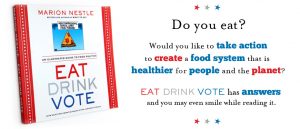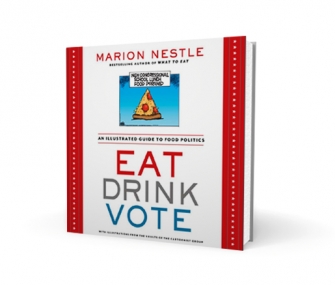The book, “Eat Drink Vote” is about issues that affect American citizens on a personal and public level. The topics range from dietary advice to fighting the obesity epidemic of fast food culture in America. The text used a lot of graphic design and cartoon images that make it easier to explain complex ideas and points of view about food issues. Cartoons and comics can easily communicate complicated information in a brief look. Good graphic design and cartoon communication is funny, pointed, sharp, ironic and sometimes even sarcastic in its suggestions by the author.

This book was divided into 10 major topics. Each topic began with a quote from various experts in the fields of food health and social-political points of view about food. The topics provided the different viewpoints of the business of food in America. They ranged from the view of farmers, consumers, marketers, parents, children, and different social classes.
Here’s some of the topics–
THE AMERICAN FOOD SYSTEM: From Farm to Table
The food industry is massive. It surrounds everyone who owns or works in agriculture, project manufacture, restaurants, institutional food service, retail stores, and factories that make farm machines and fertilizers, as well as people engaged in the transportation, storage, and insurance businesses that support such companies. Just think about the food distribution system in urban areas that have everything from fast food, a variety of restaurants, grocery stores, cafeterias, etc.
“Food is political because people have widely varying interests in its production and consumption”.
WHY FOOD PRODUCTION MATTERS: Hunger and It’s Consequences
Everyone’s health is related to the supply of food. In industrial countries there are lower birth rates, increased obesity, decreased and delayed emotional abilities, higher rates of mental illness like depression and anxiety. Why is this? Some think it is because of the mass marketing of cheap foods for profit. There is a recent study that shows addictive sugar is added to foods marketed to children and is having consequences on mental health. In addition to this, people in upper classes can afford more healthy foods while urban lower class people have more fast food and unhealthy foods as cheaper options.
“The world produces an abundance of food, more than enough to meet the needs of its more than six billion people”
The Core Democratic Values
One important Democratic Core value involved in the politics of food involves government authority and the concept of distributive justice.
Authority: The proper use of power according to written and moral law.
Distributive Justice: the nature of a socially just allocation of goods in a society. A society in which incidental inequalities in outcome do not arise would be considered a society guided by the principles of distributive justice.
How does the government regulate food and the food industry?
When it comes to food, we are forced to trust the industry. The new safety standards are modest; they do not address anything near the full range of food safety issues facing the American public. Yet, successfully enforcing even these minor changes remains a challenge. And the food industry continues to have significant influence over basic safety and public health.
Equality: a value concerning whether people should be treated in the same way. Is there such a thing as food justice? Is equal access to healthy food a human right?
Our current industrial-based food system does not adequately give equal access to healthy, nourishing food. Growing power is a national non-profit organization and land trust that supports people from diverse backgrounds and the environments in which they live by helping to provide equal access to healthy, high-quality, safe, and affordable food for people in all communities.
Liberty: a value concerning what freedoms people should have and the limits that may justifiably be placed on those freedoms. Who has the most liberty or the most CHOICE when it comes to food access?
It is anything but coincidental that kids prefer the very foods that are made and advertised to interest them. The amount of money that food advertisers spend to advertise directly to children can only be estimated, but it runs well int the billions.
Life: a value concerning when, if ever, it is justifiable to threaten or take a life. How does food affect the quality of life for Americans?
Loyalty: a value concerning obligations to people, traditions, ideas, and organizations of importance in one’s life and for society s maintenance. Should we have any loyalty to small business food producers or to local farmers?

Adopt a formal need to create a solid economy focused on local food production for local markets. Emerging local foods activity gains stronger foundation in state government, sufficient resources to grow for local markets, lasting enough that creates local ability.
Promise-Keeping: a value concerning the nature of obligations or duties that arise when promises are made. What obligation does the government have when it comes to food safety and food quality?
Although the Food and Agriculture Organization of the United Nations considers food safety to be one attribute of food quality, the U.S. Food Industry considers food safety and quality as separate attributes. The amount of market share that can be hard to capture from increased food safety efforts will depend on how well consumers can identify the safer product, how willing they are to pay for the safer product, and how well stable communicate that their products are safer to consumers.
Property: a value concerning what people should be allowed to own, and how they should be allowed to use it. How do the poor suffer in their access to basic healthy food?
Poor people in the United States suffer from slightly worse nutrition because they have such limited access to good food. Meeting with a high concentration of poor diet choices (fast food and processed food in satisfied stores) and with few markets offering fresh fruit and vegetables, the poor end up eating a less healthy diet. In this view, bad diets are a problem with the urban environment—the lack of good food in poor neighborhoods.

Truth: a value concerning the expression, distortion, or withholding of accurate information. How does American marketing affect truth in advertising the quality and health of food?
Most of the time, advertising increases market performance by providing useful information to consumers and by allowing them to promote the quality of their products and services and to compete better with each other. On the other hand, advertising may adversely affect market performance when businesses use it to relay false or fake messages on which reasonable consumers are induced to rely to their disadvantage.
Fairness: a value concerning the quality of making judgments that are just. It allows for even handed justice that is appropriate for the circumstances. Fair food access is about DISTRIBUTIVE JUSTICE. What does this mean?
The income of small-scale farmers have also been threatened by pressure on the opportunity to produce, through restricted access to the resources – such as land and capital – needed to farm; and on the opportunity to sell, through restricted access to local and global markets. The costs involved in meeting various kinds of standards are one significant barrier to export, while funding imports can damage the competitionon of farmers in domestic markets.
Here’s eight other topics covered in this book. If you pick it up you will definitely think about the politics of food differently.
WHY FOOD PRODUCTION MATTERS: Obesity and What to do about it?
WHAT ARE WE SUPPOSED TO EAT?
WHAT ABOUT FEEDING KIDS?
FOOD ISSUES: Who decides?
FOOD SAFETY: Who is responsible?
FOOD LABELS VERSUS MARKETING
FIXING THE FOOD SYSTEM: Regulations
FIXING THE FOOD SYSTEM: The Food Movement
http://www.cleanleanmommymachine.com/2013/03/cut-junk-food-makeover.html




Phizzion • Mar 29, 2016 at 2:46 pm
This is very interesting. It is very important that we learn where our food comes from, and the importance of food Regulation in the United States.